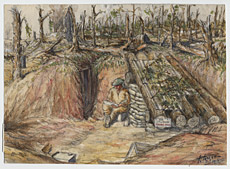Art of the First World War
May 1, 2013
The Artist’s Home at Bottom Wood, about Halfway Between Mametz and Contalmaison
Sketched by William Thurston Topham
Beaverbrook Collection of War Art
CWM 19710261-0732 © Canadian War Museum
Clouds of shell fire smoke drifting across a battlefield. The staring, terrified face of a soldier rushing at night through a trench. A German observation plane caught at night in the brilliant beams of six searchlights. A soldier relaxing with a book outside his dugout.
These diverse First World War scenes were captured in compelling drawings and sketches by soldiers or official war artists almost a century ago. In the summer of 2014, these works and dozens of others will be displayed, many for the first time, at the Canadian War Museum in an exhibition commemorating the 100th anniversary of the outbreak of war. The exhibition will allow visitors to compare soldier sketches done in the trenches with the large studio paintings of official war artists, as well as with the official artists’ preliminary sketches. Almost all of the works are from the Museum’s Beaverbrook Collection of War Art, which includes close to 13,000 paintings, drawings, posters and sculptures depicting the Canadian war experience since 1760.
“We’re excited about this show because the public hasn’t seen most of these works on paper,” says Meredith Maclean, the Museum’s Collections Manager, Art and Memorials. ”Many were done under very difficult circumstances and conditions to quickly capture an emotion or an impression. They have a remarkable immediacy and intimacy.”
The Museum’s Collection Management team is now assessing conservation and display requirements for the sketches and drawings, which are fragile compared to oil paintings. Some have been in storage for decades; all require some degree of conservation before they can be exhibited.
Protecting a National Legacy
Conservation of the drawings and sketches is a complex challenge. Most are mounted on storage mats that need to be replaced to avoid damage to the works from acidity. Before being acquired by the museum, some works were mounted with heavy glue on homemade matting and conservators must decide whether to remount these works or conserve the original supports. The works themselves are generally in superb condition — a testament to the value of preventative conservation.
Displaying the works is also a challenge. The exhibition team wants visitors to experience the works as intimately as possible, as if they were looking over the artist’s shoulder into his sketchbook. But exposure to light can damage works on paper, which must be protected by ultraviolet-blocking Plexiglas.
Depicting a New Kind of War
Organized by themes, the exhibition will explore how soldier and official artists responded to life in the trenches and to new and devastating technologies such as tanks, aircraft and modern machine guns. Many of the soldier sketches, meant to be shown to other soldiers, capture the details of military life — the tedium and routine, the discomfort, and sometimes the terror. The works of the official artists are most often quick impressions, occasionally with detailed notes on the paper, meant to be later worked up into paintings. Both kinds of artists drew on and extended a symbolic visual language — including ruins, dead trees, sunsets and sunrises — that originated with European Romantic landscape painters.
Legacy of a Great Canadian
The exhibition offers a glimpse into the extraordinary richness of the Beaverbrook Collection of War Art, the second largest war art collection in the world, after that of the Imperial War Museum in London. Recent exhibitions built around the collection includeA Brush with War: Military Art from Korea to Afghanistan, featuring close to 70 works, and The Navy: A Century in Art, featuring just over 40.
Another 2014 exhibition commemorating the First World War will present Beaverbrook Collection art from A.Y. Jackson, perhaps the best-known member of the Group of Seven, alongside works from German artist Otto Dix on loan from 20 institutions mostly in Germany. “Visitors will see the critical role that war art played in the formation of two major artists,” says Dr. Laura Brandon, Historian at the War Museum, “and also how their painting reflects distinct national identities.”
The Beaverbrook Collection is named after an extraordinary man, Canadian-born Lord Beaverbrook, who became a powerful British press baron, politician and philanthropist. Lord Beaverbrook founded the Canadian War Memorials Fund in November 1916, eventually hiring 116 artists to paint some 900 scenes of Canada at war. Over time, this collection was supplemented with war art from the Second World War and the post-war period, right up to Canada’s engagement in Afghanistan. The Beaverbrook Foundation chose the Canadian War Museum to be stewards of this extraordinary war art collection and continues to be one of the Museum’s most generous donors.
Your donation will help us conserve First World War art. For more information, call 1-800-256-6031.